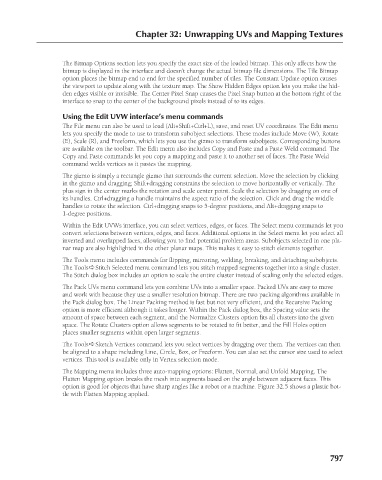Page 845 - Kitab3DsMax
P. 845
Chapter 32: Unwrapping UVs and Mapping Textures
The Bitmap Options section lets you specify the exact size of the loaded bitmap. This only affects how the
bitmap is displayed in the interface and doesn’t change the actual bitmap file dimensions. The Tile Bitmap
option places the bitmap end to end for the specified number of tiles. The Constant Update option causes
the viewport to update along with the texture map. The Show Hidden Edges option lets you make the hid-
den edges visible or invisible. The Center Pixel Snap causes the Pixel Snap button at the bottom right of the
interface to snap to the center of the background pixels instead of to its edges.
Using the Edit UVW interface’s menu commands
The File menu can also be used to load (Alt+Shift+Ctrl+L), save, and reset UV coordinates. The Edit menu
lets you specify the mode to use to transform subobject selections. These modes include Move (W), Rotate
(E), Scale (R), and Freeform, which lets you use the gizmo to transform subobjects. Corresponding buttons
are available on the toolbar. The Edit menu also includes Copy and Paste and a Paste Weld command. The
Copy and Paste commands let you copy a mapping and paste it to another set of faces. The Paste Weld
command welds vertices as it pastes the mapping.
The gizmo is simply a rectangle gizmo that surrounds the current selection. Move the selection by clicking
in the gizmo and dragging; Shift+dragging constrains the selection to move horizontally or vertically. The
plus sign in the center marks the rotation and scale center point. Scale the selection by dragging on one of
its handles. Ctrl+dragging a handle maintains the aspect ratio of the selection. Click and drag the middle
handles to rotate the selection. Ctrl+dragging snaps to 5-degree positions, and Alt+dragging snaps to
1-degree positions.
Within the Edit UVWs interface, you can select vertices, edges, or faces. The Select menu commands let you
convert selections between vertices, edges, and faces. Additional options in the Select menu let you select all
inverted and overlapped faces, allowing you to find potential problem areas. Subobjects selected in one pla-
nar map are also highlighted in the other planar maps. This makes it easy to stitch elements together.
The Tools menu includes commands for flipping, mirroring, welding, breaking, and detaching subobjects.
The Tools ➪ Stitch Selected menu command lets you stitch mapped segments together into a single cluster.
The Stitch dialog box includes an option to scale the entire cluster instead of scaling only the selected edges.
The Pack UVs menu command lets you combine UVs into a smaller space. Packed UVs are easy to move
and work with because they use a smaller resolution bitmap. There are two packing algorithms available in
the Pack dialog box. The Linear Packing method is fast but not very efficient, and the Recursive Packing
option is more efficient although it takes longer. Within the Pack dialog box, the Spacing value sets the
amount of space between each segment, and the Normalize Clusters option fits all clusters into the given
space. The Rotate Clusters option allows segments to be rotated to fit better, and the Fill Holes option
places smaller segments within open larger segments.
The Tools ➪ Sketch Vertices command lets you select vertices by dragging over them. The vertices can then
be aligned to a shape including Line, Circle, Box, or Freeform. You can also set the cursor size used to select
vertices. This tool is available only in Vertex selection mode.
The Mapping menu includes three auto-mapping options: Flatten, Normal, and Unfold Mapping. The
Flatten Mapping option breaks the mesh into segments based on the angle between adjacent faces. This
option is good for objects that have sharp angles like a robot or a machine. Figure 32.5 shows a plastic bot-
tle with Flatten Mapping applied.
797

